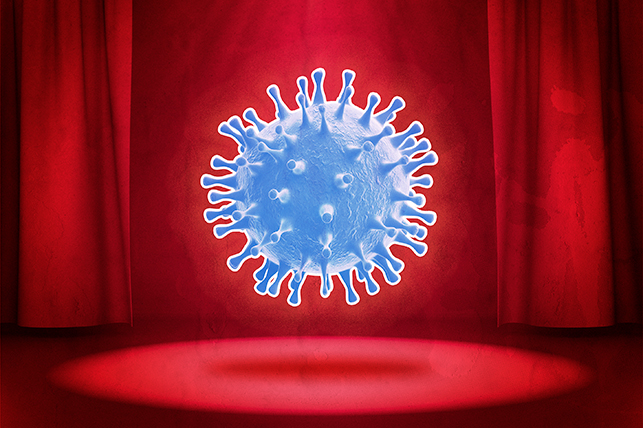Are We Being Too Complacent About COVID-19?

After about three years of living in a world infected with COVID-19, the facts have repeatedly intertwined with fiction, paranoia and political agendas.
To untangle the facts of the nature of this pandemic, let's stick to the science-backed truths.
What is it and where did it come from?
Brian Labus, Ph.D., M.P.H., assistant professor in the school of public health at the University of Nevada, Las Vegas, explained that while tracing the origin of COVID-19 is important for future prevention, it doesn't inform or aid protocol for health management.
"Understanding the origin of the virus is like fighting a fire," he said. "We want to know what caused the fire to prevent future fires, but it doesn't matter to the firefighter trying to keep the building from burning to the ground."
Consider healthcare professionals as firefighters in this metaphor and the average non-medically trained individual as the resident of the house fire. You most likely can only guarantee your or your family's safety with some help, but there are methods and techniques you can learn to have a better chance of survival.
"The most common explanation for the COVID-19 pandemic's origin is the mutation of a coronavirus virus in wild bats that became transmissible to humans," said Soumi Eachempati, M.D., CEO and chief medical officer of CLEARED4, a health IT platform based in Dallas. "Other explanations have included a 'lab leak' where coronavirus being studied in a lab somehow infected a human. The infection's origin does matter because scientists may be able to create and utilize surveillance standards for animals and laboratory workers to prevent future infections."
Labus contextualized coronavirus within a larger family of illnesses. COVID-19, which stands for coronavirus disease 2019, is caused by a virus named SARS-CoV-2.
"The virus that causes COVID-19 is part of a family of viruses that can cross to another species," he explained. "This often causes a very different disease than was seen in the host species, which is often mild or asymptomatic."
Those varying levels of intensity and unforeseen interspecies jumps are part of what makes COVID-19 much more dangerous than its cousin viruses.
The coronavirus family also includes Middle East respiratory syndrome (MERS) and severe acute respiratory syndrome (SARS). And like COVID-19, both illnesses are species-hopping illnesses the first from camels, the latter from bats and, as their names indicate, target the respiratory system.
Eachempati said a comparison of these cousins of COVID-19 is important to understanding the origins of the disease.
"Coronaviruses are from a family of specific RNA viruses," he noted, referring to viruses in which the genetic material is ribonucleic acid. "The viruses that caused SARS and MERS earlier in the 21st century were all coronaviruses. Other coronaviruses cause less severe symptoms and lead to common colds."
Although MERS and SARS carry notably higher fatality rates than COVID-19, they have affected much smaller populations. Simply compare COVID-19's fatality rate of 2.3 percent with SARS at 9.5 percent or MERS at 34.4 percent. However, SARS infected an estimated total of 8,098 people during its 2003 outbreak and MERS a total of 2,603 lab-confirmed cases in 2012. The reason these lethal viruses didn't have the international traction we saw with COVID-19 is that they don't spread as quickly.
COVID-19, on the other hand, is notoriously contagious.
How coronavirus spreads
Labus noted the spread of coronavirus through unclean surfaces is both counterintuitive and rare.
"The time SARS-CoV-2 can survive on a surface varies widely depending on the type of surface," Labus said. "Laboratory studies have shown a 99 percent reduction in infectious viruses in typical indoor conditions. More importantly, surface transmission has been rare over the course of the pandemic, with the vast majority of the disease being transmitted through direct contact with infected people. Laboratory studies have found that the virus can survive longer on nonporous surfaces than porous surfaces. Even if you come in contact with the live virus on a surface, the risk of infection is very low and is thought to only be about 1 in 10,000."
In short, no one needs to wipe down their groceries with sanitizer anymore, unless you enjoy that activity.
Labus added that while COVID-19 is confirmed to spread through airborne particles, what's not confirmed is the distance that keeps people totally safe.
"While we have told people to socially distance to reduce the risk of transmission, there isn't a magic wall six feet away where the transmission cannot occur," he said. "The highest risk for transmission of COVID-19 comes from extended, close contact with someone who is infectious, and this risk goes up if a person is very infectious and ventilation is bad."
Investing in better ventilation has been a necessary purchase for most businesses recently, but other factors are at play, too.
Risks and causes
Office spaces and workplaces were the environments that were most affected by the pandemic.
"Coronavirus in standard conversations may spread from two to six feet," Eachempati said. "However, certain factors such as wind, coughing, singing and yelling can increase this distance by possibly 10 to 15 feet."
So if you're that guy, please, no more singing in the workplace.
"Notably, the viability of the virus does not necessarily equate to contagiousness, as the number of viral particles after minutes on these surfaces may become quite small. In the air, aerosolized viral particles may be alive for three hours," Eachempati explained, further complicating the formula for keeping out of infection's way.
Dung Trinh, M.D., founder of Healthy Brain Clinic in Long Beach, California, recommended the unexpected benefits of fresh ocean air.
"Humidity reduces the likelihood to catch COVID-19," he said. "Those who live close to the ocean with an ocean breeze are noted to have lower infection risk."
"The environment plays a role in how long the virus can survive outside the body, but more importantly, the weather changes our behavior and that's what really changes our risk of disease," Labus explained. "When it's cold outside, we spend much more time inside and in close contact with others and we can't participate in outdoor activities with a lower risk of exposure. This is one of the many reasons cold weather is associated with a spike in cases of the flu and colds. And now COVID-19."
The facts speak for themselves
"The World Health Organization has said that the pandemic is probably [at] a transition point," Labus noted. "While COVID-19 is still a serious disease and a public health threat, our response is moving from one of dealing with a pandemic to one that is dealing with COVID-19 as an endemic disease and something we are likely to deal with every year, just like flu."
Though the coronavirus has become part of our new normal, the impact of COVID-19 on our society has also exacerbated certain preexisting flaws.
"An eye-opening study discussed opinions on public health officials," Eachempati said. "Interestingly, there was a lot of negativity regarding trusting officials to manage a pandemic response. This information may yield insight into potential calamities if followed by the same methods to treat the next pandemic."
The results of the survey carried out in December 2022 indicated only 55 percent of adults in the United States trusted public health institutions to manage a future pandemic based on how the COVID-19 crisis was handled. About 37 percent said they would not trust public health institutions to handle a similar crisis.
Although the COVID-19 pandemic has now been branded an endemic by some healthcare professionals, there are still the consequences of "long COVID," or when people suffer long-term effects of coronavirus infection. General symptoms of long COVID include "brain fog," chest pain and palpitations, fatigue and fever, respiratory problems and sleep disorders. And financial implications for all U.S. taxpayers are likely.
"Long COVID will continue to be a major healthcare issue even after the current pandemic wanes," Eachempati explained. "This disease affects every organ system and has an estimated $3.7 trillion in future costs."
Staying safe and maintaining distance from possible infections remains a personal responsibility everyone should keep in mind. Its status has changed, but we still live with COVID-19 every day. As of mid-March 2023 in the United States, there are still more than 20,000 new cases per day running total adding up to more than 7 million cases this year.


















